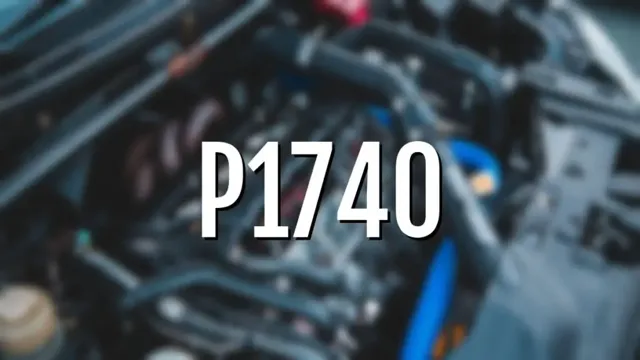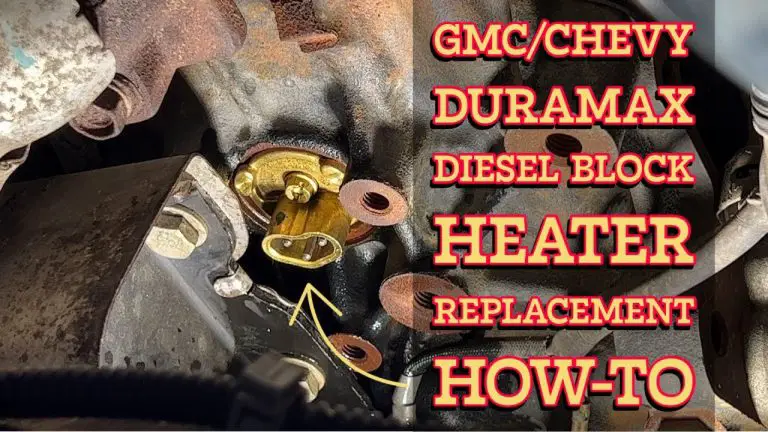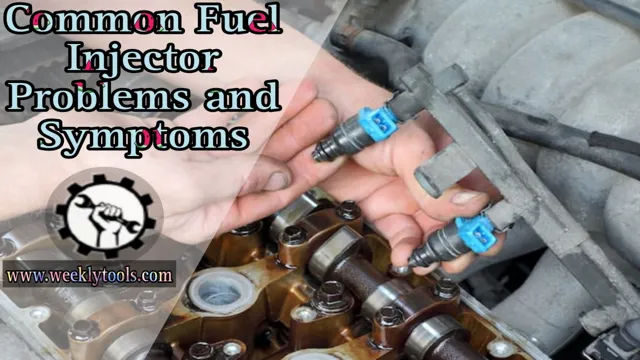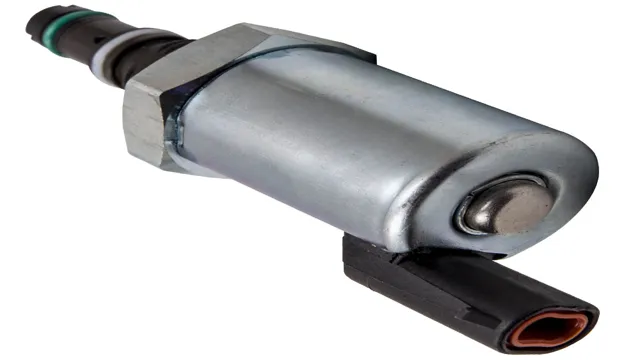Ultimate Guide: Troubleshooting and Fixing P1740 Code Like a Pro
If you own a car, you have likely experienced the frustration of seeing a warning light pop up on your dashboard. Especially when you don’t know what it means. One of the most common error codes is the dreaded P1740 code.
This code is also known as a transmission code, and it can be challenging to fix without knowing what to do. Fortunately, we are here with a simple guide to help you fix the P1740 code, so you can get back on the road safely and easily. The P1740 code is a transmission code that indicates a problem with the lock-up torque converter clutch.
This lock-up clutch is responsible for providing a direct connection between the engine and the transmission once you reach a certain speed. If this clutch fails to engage, the code will trigger, and your car’s performance will suffer. In other words, your engine will rev higher than usual, even when you are maintaining a steady speed, which can result in decreased fuel efficiency.
If you see this code on your dashboard, don’t panic. You can take some steps to fix it yourself, rather than spending a lot of money on a visit to the mechanic. The first thing to do is to check the transmission fluid level.
Low fluid levels can cause P1740 to appear, so ensure that it is at the correct level before doing anything else. From there, you can move on to other potential causes. There are several ways to fix the P1740 code, depending on the root cause.
This guide will walk you through the process, step by step. It’s a simple guide that provides basic information about checking and fixing the error codes and helps you save time and money. So, read on to learn more about how to fix the P1740 code and regain the optimal performance of your car’s transmission.
Understanding P1740 Code
If you’re dealing with a P1740 code, don’t worry, it’s a common issue with many solutions. The P1740 code is related to the torque converter clutch, which is responsible for engaging and disengaging the clutch in your transmission. There are a few reasons why this code may pop up, including a faulty solenoid or wiring, worn transmission parts, or low transmission fluid.
Fixing the P1740 code requires first identifying the specific issue causing it. If it’s a faulty solenoid or wiring, replacing or repairing those components should do the trick. If it’s a more significant issue, such as worn transmission parts, you may need to consider a transmission rebuild or replacement.
Additionally, make sure to check your transmission fluid levels regularly and get them topped off if they’re low. Overall, fixing the P1740 code will require some troubleshooting and potentially some repairs, but it’s an issue that can be resolved with the help of a qualified mechanic.
What is P1740 Code?
P1740 code If you own a vehicle and the check engine light suddenly turns on, the first thing that comes to mind is to find out what’s wrong. One of the most common codes that car owners encounter is the P1740 code. This code indicates a transmission-related issue.
Basically, the P1740 code means that the TCC (torque converter clutch) is stuck in the “on” position, which can result in reduced fuel economy and overheating. There are a few reasons why this code could appear, ranging from a malfunctioning solenoid valve to damaged wiring. If you notice this code on your car, it’s important to get it checked out by a professional to avoid further damage and costly repairs.
Additionally, it’s always a good idea to stay on top of your vehicle’s regular maintenance to prevent issues like this from occurring in the first place.
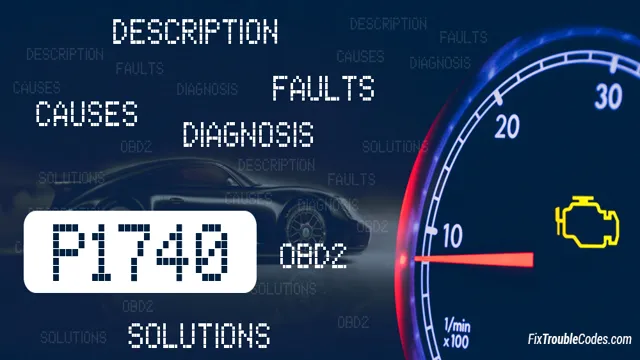
Common Symptoms of P1740 Code
If you’re experiencing problems with your vehicle, and the check engine light has come on, there’s a code you should know about – P1740. Understanding what this code means is essential, and it can help you diagnose and fix the underlying issue. P1740 is a transmission-related code, and it indicates a problem with the TCC (Torque Converter Clutch) or the transmission solenoid.
The most common symptom of a P1740 code is a failure of the transmission to shift gears smoothly or efficiently. This can result in jerking motions or shuddering, particularly when accelerating or decelerating. Other potential symptoms of P1740 could include reduced fuel efficiency or a complete loss of power.
If you’re experiencing any of these symptoms, it’s time to take your car to a professional mechanic for a thorough diagnosis. Don’t put off addressing the issue, as ignoring it could lead to more significant problems down the line.
Troubleshooting P1740 Code
If you’re experiencing a P1740 code, also known as a torque converter clutch circuit malfunction, there are a few things you can do to troubleshoot the problem. One common issue is a faulty torque converter clutch solenoid, which can prevent the solenoid from engaging or disengaging correctly. You can check the resistance of the solenoid using a multimeter, and if it’s out of range, you may need to replace it.
Another issue could be a buildup of debris or metal shavings in the transmission system, which can affect the performance of the torque converter clutch. A transmission fluid flush and filter replacement may be necessary to address this problem. If all else fails, it’s best to bring your vehicle to a trusted mechanic who can diagnose and repair the issue.
With these steps, you can fix the P1740 code and ensure your vehicle is running smoothly.
Step-by-Step Guide to Fixing P1740 Code
If you’ve detected the P1740 code on your vehicle, it’s important to act fast to avoid any further damage to your transmission system. This code indicates a problem with the torque converter clutch system and can result in poor fuel efficiency and transmission slipping. Luckily, troubleshooting and fixing the issue is a relatively straightforward process that can save you money in the long run.
Start by checking the ATF level and color and inspecting the wiring and connections to the system. If those checks don’t identify the problem, you may need to replace the torque converter clutch solenoid or the torque converter itself. It’s important to address the issue as quickly as possible to avoid any further complications down the line.
With a little bit of patience and attention to detail, you’ll be able to resolve the P1740 code and enjoy a smoothly operating transmission system once again.
Using Diagnostic Tools to Identify Problems
If you own a Dodge Ram truck and have experienced transmission problems, one of the diagnostic codes you may encounter is the P1740 code. This code indicates that there may be issues with the torque converter clutch solenoid circuit. To troubleshoot the problem, the first step is to use a code reader to clear the code and then drive the truck to see if the code returns.
If it does, the next step is to perform a visual inspection of the wiring and connectors to ensure they are clean and complete. If no issues are found, the torque converter clutch solenoid may need to be tested or replaced. It’s important to take the necessary steps to address the P1740 code promptly as it can lead to further damage and costly repairs down the line.
With proper diagnosis and repair, your Dodge Ram can be up and running smoothly once again.
Checking Transmission Fluid and Filter
When troubleshooting the P1740 code, checking the vehicle’s transmission fluid and filter is essential. The P1740 code is related to the torque converter clutch system and can indicate low fluid levels or a blocked filter. To check the fluid level, first, park the car on a level surface and turn off the engine.
Locate the transmission dipstick and remove it to check the fluid level, which should be between the minimum and maximum marks. If the fluid level is low, add some according to the manufacturer’s recommendations. Next, inspect the transmission filter for any debris, clogs, or signs of wear and tear.
If the filter is clogged, it should be replaced immediately. Neglecting to replace a clogged filter can cause significant damage to the transmission and other nearby components, resulting in costly repairs down the line. In summary, keeping an eye on the transmission fluid and filter can help prevent the P1740 code and other transmission-related issues from occurring.
Preventing P1740 Code
If you’re experiencing the P1740 code in your vehicle, don’t fret – there are several steps you can take to try and prevent it from appearing again. This code is often linked to issues in the torque converter clutch or transmission, so it’s essential to keep your vehicle maintained and keep an eye out for any unusual noises or vibrations. One simple preventative step is to get regular fluid changes, as dirty transmission fluid can cause damage and lead to the P1740 code.
Additionally, it’s important to avoid heavy acceleration or abrupt shifting, as these actions can put unnecessary strain on your transmission. Lastly, make sure to get your vehicle inspected at the first sign of any trouble, as catching small issues early can save you from more significant and costly repairs down the line. By following these tips, you may be able to avoid the P1740 code and ensure your vehicle’s longevity and performance.
Regular Maintenance Tips
Regular maintenance is key when it comes to preventing the P1740 code from showing up in your car. To avoid this code, it’s important to change your transmission fluid on a regular basis. Over time, transmission fluid can become dirty and break down, which can cause damage to your transmission and trigger the P1740 code.
It’s also recommended to replace your transmission filter at the same time as changing your fluid. In addition to fluid maintenance, it’s important to have your transmission inspected regularly by a professional mechanic. They can identify any potential issues before they turn into larger, more costly problems.
By keeping up with regular maintenance, you can prevent the P1740 code from appearing and ensure the longevity of your transmission.
Driving Habits that Affect Your Transmission
When it comes to taking care of your vehicle, there are a few driving habits that can affect your transmission, leading to the dreaded P1740 code. This code indicates that there is a problem with your transmission, often caused by issues with the torque converter or other internal components of the transmission system. To prevent this code from appearing, it is important to avoid habits like overloading your vehicle, accelerating aggressively, or failing to maintain your transmission fluid.
Additionally, taking your car in for regular maintenance and inspections can help catch any potential transmission problems before they become serious. Remember, your transmission is a vital part of your vehicle, and taking care of it can save you from costly repairs down the road.
Conclusion: P1740 Code Fixed!
Fixing a P1740 code is like solving a puzzle. It requires patience, knowledge, and the right tools. But unlike a puzzle, there’s no magic trick or shortcut to fix it.
You have to diagnose the problem, check the components, and make the necessary repairs. In the end, the solution may not be as flashy as a magic trick, but it will give you peace of mind knowing that your vehicle is running smoothly and efficiently. So, put on your thinking cap, grab your wrenches, and let’s fix that P1740 code!”
FAQs
What is a P1740 code?
The P1740 code is a transmission code indicating a problem with the torque converter clutch control circuit.
What are symptoms of a P1740 code?
Symptoms of a P1740 code may include a check engine light, harsh shifts or slipping, and decreased fuel economy.
Can I still drive with a P1740 code?
It is possible to drive with a P1740 code, but it is recommended to have the issue addressed as soon as possible to avoid further transmission damage.
How can I fix a P1740 code?
To fix a P1740 code, the torque converter clutch control circuit will need to be inspected and repaired as necessary. This may involve replacing faulty wiring or a defective solenoid.
Will a P1740 code affect the performance of my vehicle?
Yes, a P1740 code can affect the performance of your vehicle by causing shifting issues and decreased fuel economy. It is important to have the issue resolved to maintain optimal performance.

